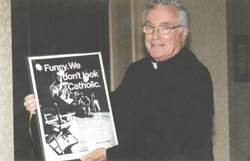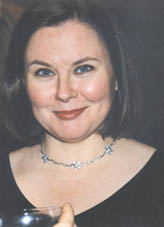|

Communication
Studies alumni, professors and staff reminisced during a two-day open
house. It culminated in a celebratory dinner at the downtown Parc Renaissance
Hotel last Saturday, at which Professor Lorna Roth (above) gave a lively
speech.

Professor Bill Gilsdorf, a former Chair, at the reception.

Founder Fr. John O’Brien with an advertisement from the early days
of Communication Arts at Loyola College, which ran in Time Magazine
in 1967.

Broadcaster
Carmel Kilkenny (BA 86), helped organize the event, along with Assistant
to the Chair Sheelah O’Neill, Professor Dennis Murphy and Lecturer
Margaret Gourlay.
|
|
by Anna Bratulic
In 1965, Expo 67 was just around the corner. Montreal would be catapulted
onto the world’s stage for the first time.
Nine students in the fledgling Communication Arts Department at Loyola
College — the first program of its kind in Canada — assigned
themselves the task of letting the rest of North America know.
Armed with charts and presentations, they “knocked on doors, bothered
secretaries and made 85,000 phone calls,” according to Don Taddeo,
now head of the McGill University Health Centre Foundation.
They told the organizers that if they were provided with a few cars (say,
from General Motors) and sponsorship for food and accommodation, they
were willing to travel the continent to publicize Expo. They would set
up TV and radio interviews. They had maps and contact numbers for all
the stations.
In the end, the idea was turned down, probably because it was too expensive,
but the experience had a deep effect on them. “The nine of us just
spent all our time in the office and library preparing this thing,”
Dennis Murphy recalled.
“We did professional presentations, we sang Beatles songs in Ottawa,
we went to the offices of the Expo Corporation in Place Ville-Marie. It
really pulled us all together.”
Murphy was a member of the first graduating class in 1967, and has been
teaching in the department ever since. “We never got the job, we
didn’t get the cars. But — but — it was a great, cohesive
kind of thing, and I think it set the tone for how this department operates.”
It operates in small groups where everybody knows everybody and practical
hands-on work is prized as much as the theoretical. This has been a hallmark
of the department since it was first started in 1965 by Father Jack O’Brien,
S.J.
The beginnings of Communication Arts (later Communication Studies) can
be traced back to a Society of Jesus conference in Rome, the holy halls
of the Vatican and a papal ecumenical letter that noted the growing importance
of media and the need to study it further.
Father O’Brien returned to Canada thinking about that. After all,
Marshall McLuhan, who once lectured at Loyola College, was jolting academia
with his ideas about the impact mass media would have in the modern age.
The following year, Father O’Brien offered a communications course,
which could be taken as a substitute for English. He was told by the dean
not to feel bad if only a small number of students enrolled. Six to 10
students would be reasonable.
However, 75 people registered, and the class was held in a basement auditorium
in the Vanier Library. The Communication Arts program began the next year
in 1965.
Some people thought of it as “nonsense, fluffy and gimmicky,”
according to Taddeo. Although he is not a graduate of the department,
Taddeo has been deeply involved in it for years, both as a Classics major
taking Communications electives in the 1960s, and as a teacher.
The program has always received more applications than it could accommodate.
Many of the department’s first graduates have gone on to successful
careers. They include journalists and broadcasters Hana Gartner, Natalie
Petrowski, Agnès Gruda, Carmel Kilkenny, Bob O’Reilly (Radio-Canada
International), Michel-Claude Lavoie (the Canadian version of Sesame Street),
Brian McKenna, sex columnist Josey Vogels, and Me, Mom and Morgentaler
alumna Kim Bingham.
The Communication Studies Department offers four undergraduate programs:
a major and a specialization in Communication Studies, a major in Communication
and Cultural Studies, and a specialization in Communications and Journalism.
In addition, a one-year graduate diploma, a Master’s and a PhD program
are offered jointly with the Université de Montréal and
the Université du Québec Montréal.
Scholarships in
memory of Denis Diniacopoulos
Future Communication Studies
students are getting new funding to help them pursue their studies.
The family of Professor Denis Diniacopoulos, who passed away in 1997,
have made a generous gift to the university for scholarships for four
undergraduates in Communication Studies, two in Classics/Fine Arts, two
in Mathematics, and two in Psychology, reflecting Diniacopoulos’s
varied interests.
Diniacopoulos also left 14 years of BBC tapes that even the BBC does not
have. CD copies of these reel-to-reel tapes have been given to Concordia’s
Centre for Broadcast Studies, and funding will be available for graduate
students who want to research the content.
|
|
|

